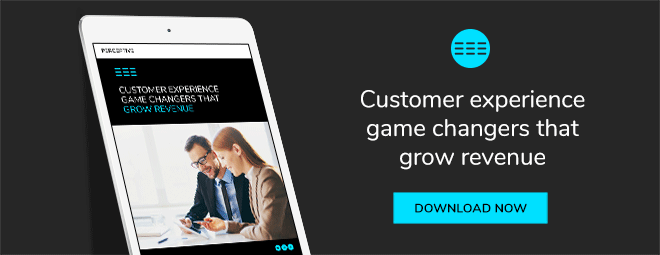
Did you know that it takes more than double (some reports say even twelve) positive experiences with a company to make up for one unresolved negative experience? Although everyone makes mistakes in business, you wouldn’t want to be in the habit of having to put in up to twelve times of work to keep the same customer happy.
“The customer’s perception is your reality”, says Kate Zabriskie, learning and development industry veteran, and we tend to agree.
Bad news travels fast
Be aware that bad news travels fast - a whole lot faster than good news. So if a customer has had a bad experience with you, it’s likely they’ll tell their friends and even post about their disappointing experience on Facebook (isn’t that what social media is all about?).
It's a scary fact, but if people have a good experience they'll tell three of their friends about it. However if they have a bad experience you can bet on them telling about eleven of their friends. Word of mouth is a powerful thing!
Effectively, each interaction a customer has with your brand will determine how they view your brand. This will be decided by all of their individual interactions with you (and that will then determine whether they buy your product or not, tell their friends about their amazing experience etc). If they’ve had a positive experience, it’s more likely they will bring return business your way.
4 things to do
1. Set and meet customer expectations
Expectations are set right from the first contact a customer has with your business. This can be with your sales person or a customer service representative on the phone, even your receptionist.
- How? Make sure everyone in your business understands your company’s mission, the values of your brand (i.e. what you stand for) and is aligned with what promises to make to customers and how to best deliver on customer expectations.
- Why? This will go a long way to building customer loyalty and gaining trust. In the long run, this contributes to increased customer satisfaction and reduced churn.
2. First impressions count
Always. It’s all about having that “wow” factor (or “X-factor”, if you like).
- How? Help customers experience that “wow” moment as quickly as possible during their first interaction with your business. Basically, deliver more than they’re expecting and you’re in the game.
- Why? Missed the bit about first impressions counting? As mentioned, once a customer has had a bad experience with you, it usually takes a satisfactory resolution, and a fair few positive experiences to make up for that one rotten occasion (which they’ll tell their friends all about. Let’s face it, it can make for good water-cooler fodder).
3. What makes you unique?
In today’s competitive and cluttered marketplace, you have to stand out to be considered. Why should people choose you if others are offering exactly what you do?
- How? Identify and improve your points of difference. Why should anyone use your product?
- What makes you special? Clearly define what the benefits of using your product or service are (as opposed to just focusing on features).What is your company brilliant at and what is it that only you can provide? If you can’t figure out what this is, that’s a red flag. Or, maybe you just need to hire a good branding agency.
- Research your competitors. Is there anything they’re doing that you’re doing better? Identify their weak points and use them to make your awesomeness shine in your dealings with your customers.
- Why? Having a clear point of difference gives you the competitive advantage.
4. Add value
Ensure your product or service actually adds value to your customers. You’d be surprised at how many companies offer generic solutions which anyone can replicate. Add value where you can and where it matters.
- How? Adding value doesn’t necessarily mean adding new features or services, it can also be making improvements to your existing offerings. Saving customers admin time or reducing niggly processes (like billing, registration or – gasp – those cringe-worthy automated telephone services, which can make your customers tear their hair out in frustration) is always a welcome thing.
- Why? By creating a value-added experience, where you always “bring it” (i.e. give your clients some form of additional value) you’re helping to educate your customers on the true value of your offering. This creates a more ‘sticky’ relationship that is less likely to churn.
1. Listen!
The easiest and most powerful tactic. In the words of acclaimed author Stephen Covey; "Seek first to understand, then to be understood." If you want your customers to know what you’re all about and understand how your business can help them, you must first listen and understand the issues they’re experiencing. Then, you can respond in a relevant and credible fashion to their concerns.
- How? Actually talk and listen to your customers so you can learn what they like and don’t like about your product or service.
- Why? An interesting fact is that 15% of incremental sales can be won through focusing on creating personalised experiences.1 Understanding who your customers are, what excites them, what annoys them and what they appreciate, will help you tailor your services to your customers.
2. Benchmark against your competitors
No business is immune to unhappy customers. In fact, even companies with the best customer service in the world will still lose up to 9% of their customers to competitors.
- How? Benchmark your performance and customer satisfaction levels against your competitors and others in your industry. Check out the Net Promoter Score℠ 2014 Industry Benchmarks for New Zealand to learn more.
- Why? When you have insight into how you’re performing against the industry average, you can determine what you have to do to boost your performance levels if needed.
3. Adopt a customer mindset
If you put the customer experience first in all of your business endeavours, you really can’t go wrong.
- How? Think “customer first”. Don’t focus purely on sales – focus on keeping customers loyal.
- Why? Again, keeping a customer mindset helps you be relevant and respond to their needs.
4. Turn a no into a yes
Turn your detractors into promoters. Impossible you say? Not so.
- How? Identifying your most at risk customers and turning them into promoters of your business is achievable. In fact there are examples where this actually as led to a profit for the company.
- Why? This one is a given. Creating “yay-sayers” out of your naysayers should reap you rewards in terms of your bottom line.
Remember that keeping your existing customers loyal is more cost efficient than constantly trying to acquire new customers. The stats say it all; a 5% lift in customer retention will actually result in an increase in profit in upwards of 30%.2 This is due to the combination of the cost of replacing the lost customers with new ones (for example through advertising, managing sales and time spent for conversion) and their lifetime value. Making sure your business is tracking well through monitoring customer experience and your NPS score is key.
So, do you truly know how your consumers feel about you and your services ? The only way to find out is by asking them. You can do this via a customer survey or by using the NPS® score.
Learn the customer experience strategies to grow your business and your bottom line in our free CX game changers guide!
